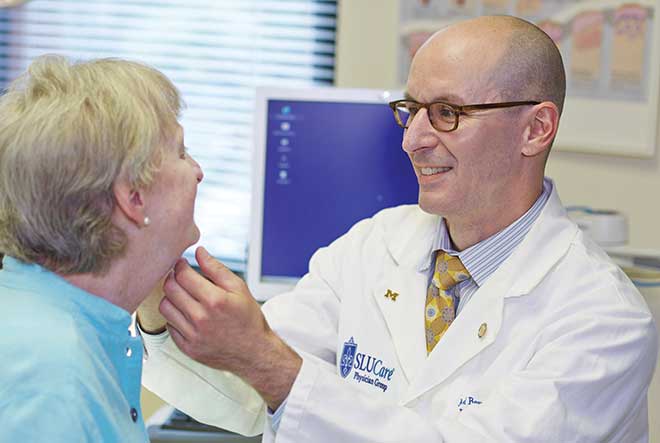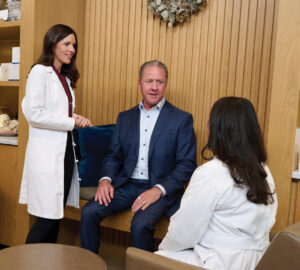Skin cancer treatment isn’t only about getting rid of the disease. Proper wound closure and reconstruction of the area, especially when the cancer occurs on the face, are essential. Treatment left one local woman, for example, without part of her nose, but thanks to the coordinated, comprehensive care offered by SLUCare Physician Group, today she looks completely normal, says Dr. Michael Bernstein, a SLUCare facial cosmetic surgeon.
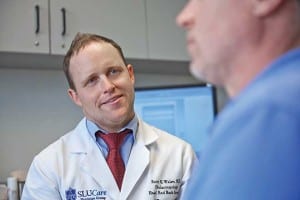
Rates of skin cancer—the most common cancer in the U.S.—have increased in recent years, with the trend predicted to continue, says SLUCare’s Dr. Ian Maher, a Mohs surgeon and assistant professor of dermatology at Saint Louis University. SLUCare, which brings together dermatologists, plastic surgeons, ENT specialists and oncologists, is equipped to handle a broad range of cases, from the simplest to the most complex. “We have a broad talent pool across all relevant disciplines,” Maher says. “It’s a good team with no weak spots.”
The first stop for patients is often Maher, who also is a member of the National Council for Skin Cancer Prevention. He performs Mohs surgery, the most accurate method of removing nonmelanoma types of skin cancer, including squamous cell and basal cell cancers. The outpatient procedure requires only local anesthesia and removes thin layers of cancerous skin until only healthy tissue remains. After each layer is removed, it is examined while the patient waits. “It takes just a few minutes to remove the abnormal tissue and up to an hour to process the results,” Maher says. “The patient leaves knowing with highest assurances that the cancer is gone.”
Those with melanoma, a more aggressive form of the disease, are treated with geometric staged excision, also known as ‘Slow Mohs.’ A modified form of Mohs surgery, this procedure requires tissue to be examined by a pathologist, which takes about five days. “For melanoma, this gives us a much higher cure rate than we can achieve with conventional margins,” Maher says.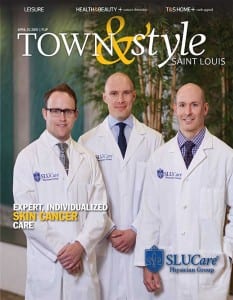
The majority of skin cancer patients are successfully and safely healed through Mohs surgery with excellent cosmetic outcomes under local anesthesia, but Maher adds that some wounds may be too large to repair using local anesthesia, or that some patients prefer being sedated for their repair. “We’re lucky to have a team of talented reconstructionists at SLU,” he notes. “Whether it’s Dr. Bernstein, Dr. Walen, a facial cosmetic surgeon, or myself, we’re always pushing to get the best cosmetic result for our patients in the setting that best suits their individual needs.”
For a small percentage of skin cancer patients, wounds from these two procedures can be sizable, and extensive reconstruction is sometimes needed. To ensure patients get the most beneficial wound treatment, Maher coordinates with Bernstein and Walen. “Due to factors like age, medications, ability to withstand anesthetic, cosmetic expectations and the amount of downtime patients can afford, no one closure type suits everyone,” Walen says. “When the patient comes in for a consultation, we discuss all these factors and the available options, and we come up with a realistic plan together with the patient.”
Those with skin cancer on the head and neck often land in Walen’s office. “The defect can occur on sensitive areas like the ears, eyelids, nose or around the mouth,” he says. “I reconstruct those wounds in order to provide patients with full function and good cosmetic appearance.” Patients with large wounds that need extensive reconstruction go to Bernstein, who also is an assistant professor of plastic surgery at Saint Louis University. “I perform the particularly complicated Mohs reconstructions and do a lot of facial and nasal reconstructions,” he explains, adding that he often sees patients with high aesthetic requirements.
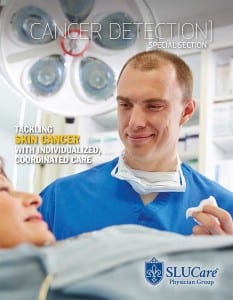
Bernstein also removes skin cancer from patients whose disease extends deep into the skin, including those with dermatofibrosarcoma protuberans, a rare form that begins in the skin’s middle layer. One patient he recently operated on was a man who had skin cancer on his face that was too deep for Mohs removal and also dangerously close to the facial nerve, threatening facial paralysis. “We wanted to avoid severing that nerve, which controls all the facial muscles,” Bernstein says.
Thanks to Bernstein’s expertise, patients often heal with no visible defects, he says. “I can return our patients very close to where they were before,” he notes. “I can’t give them back everything they lost, but I often can get them to a place where the average person wouldn’t realize they had this giant skin cancer removed.”
The cross-discipline collaboration practiced at SLUCare is essential to providing the best possible care, Maher says. “We get all types of skin cancer cases, and we get people from all walks of life,” he notes. “The ability to be versatile and to offer individualized treatment is necessary for delivering the best care to such a large group of people with a broad set of needs.”
The doctors’ affiliation with Saint Louis University Medical School also gives them cutting-edge access to the most up-to-date, evidence-based treatments, Walen says. “We have residents doing five years of surgical residency to learn what we do,” he explains. “Everything we do has evidence behind it, and we’re constantly researching and innovating to improve care.”
The experiences of St. Louisan James Dodd speak to the kind of care patients receive through SLUCare Physician Group. Earlier this spring, Maher removed the squamous cell carcinoma on Dodd’s nose, while Bernstein repaired the wound on the same day. “I’m very pleased with the result,” Dodd says. “I tell people I’ve had surgery, and they look at me puzzled and ask where. It’s only been a few weeks, but when I went for the follow-up, the nurse did a double take because it looked normal so quickly.”
Although SLUCare Physician Group has the full toolbox when it comes to combating skin cancer, Maher stresses the importance of prevention. People need to make sure they’re taking daily steps to protect themselves,” he says. “Wear sunscreen, perform monthly skin exams, and have your primary care physician look you over. If you have a family history of skin cancer, you should be seeing a dermatologist annually.”
Pictured: Dr. Michael Bernstein, a SLUCare facial cosmetic surgeon
Photos courtesy of SLUCare
SLUCare Physician Group treats the entire spectrum of skin cancer cases at its offices at 1755 S. Grand Blvd, Ste. 210 and 2315 Dougherty Ferry Road, Ste. 200A. Its dermatologists are experts in treating the disease, but also can turn to the expertise of a wide range of specialists, including plastic surgeons and ENT specialists. Pictured on the cover: facial cosmetic surgeon Dr. Scott Walen, Mohs and dermatologic surgeon Dr. Ian Maher and plastic surgeon Dr. Michael Bernstein. For more information, call 314.256.3420 or visit slucare.edu/mohs. For information on skin cancer prevention, visit slucare.edu/sun.





